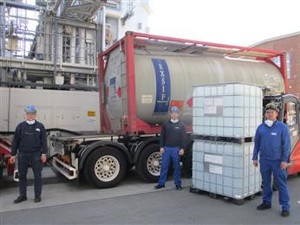Clariant’s global climate campaign cuts more than 4 MMtons CO2 equivalents annually and wins prestigious ACC Sustainability Leadership Award
Clariant announced that it has been awarded by the American Chemistry Council (ACC) with the prestigious Sustainability Leadership Award 2022 in the category “Environmental Protection”.
The accolade is in recognition of Clariant’s global climate initiative, in which the company offered a free load of its nitrous oxide (N2O) removal catalyst EnviCat N2O-S to ten nitric acid producers who did not have such an abatement technology in place yet.
After strong interest and numerous applications, an independent attorney has now drawn the winning companies. With a combined annual nitric acid production of more than 2 MMtons, the companies will be able to reduce their N2O emissions by more than 4 MMtons of CO2 equivalents annually when using EnviCat N2O-S. This translates into more than 860,000 gasoline passenger vehicles driven for one year. The catalyst is proven to effectively remove up to 95% of harmful N2O emissions.
The ten winners of Clariant’s climate campaign, in alphabetical order:
− Egyptian Chemical Industries KIMA, Egypt
− Gemlik Gubre, Turkey
− Gujarat Narmada Valley Fertilizers and Chemicals, India
− Jiangsu Huachang Chemical, China
− LSB Industries, USA
− Proman, Trinidad and Tobago
− Sichuan Lutianhua, China
− One further nitric acid producer from China
− One further producer from India
− One further producer from the USA
Conrad Keijzer, Chief Executive Officer at Clariant, commented, “We are grateful to the ACC for acknowledging our efforts with the Sustainability Leadership Award for the second year in a row. In 2021, we were recognized for our low-carbon footprint Glucamide surfactants, and this year for our global N2O reduction campaign. This proves our purpose-led strategy driving towards sustainability transformation, both in our own company and for our customers.”
Stefan Heuser, Senior Vice President and General Manager at Clariant Catalysts, added, “Globally, around half of all 500 nitric acid plants operate without N2O removal technology. Through our campaign, we wanted to show the industry that the problem is serious, yet the solution is simple. We are pleased to have converted our winning nitric acid producers into N2O reducers, and the strong interest in our initiative gives us hope that many others will follow.”
Chris Jahn, President and CEO of the American Chemistry Council, stated, “Judged by an external panel of experts, the Sustainability Leadership Award recognizes outstanding initiatives led by chemical industry visionaries advancing sustainability. Clariant is dedicated to developing innovative products that can considerably reduce its customers’ environmental footprint. We applaud Clariant on their achievement, and the impact their products make on helping create a better, more sustainable world.”
Nitric acid is a highly valuable chemical. Approximately 65.5 MMtons are produced annually around the world, mainly as a base material for fertilizers. However, its production creates large amounts of N2O as a by-product, which is extremely harmful to the climate. N2O molecules remain in the atmosphere for an average of 114 years, which is 25 times longer than CO2 molecules.
Consequently, the impact of N2O on global warming is almost 300 times that of CO2. Annual N2O emissions from the production of nitric acid and its derivative adipic acid are equivalent to around 100 MMtons of CO2 equivalents.
EnviCat N2O-S is a convenient “drop-in” solution that can be easily installed in virtually any nitric acid plant to effectively reduce N2O emissions. The catalyst is commercially proven to convert up to 95% of the greenhouse gas into harmless nitrogen and oxygen.
Clariant’s EnviCat N2O emission control catalysts are already installed globally in more than 45 nitric acid production plants. Combined, they help to reduce annual N2O emissions equivalent to more than 20 MM metric tons of CO2
.







Comments